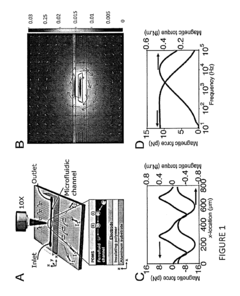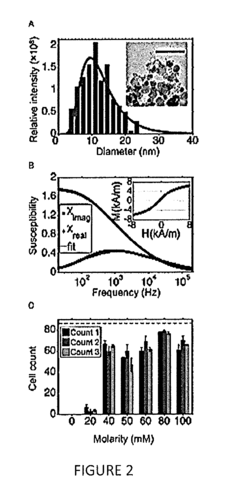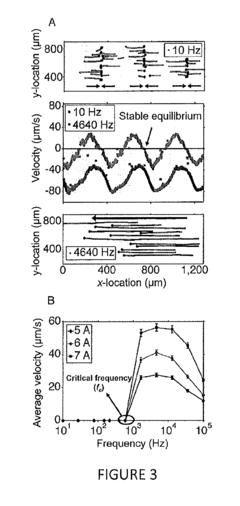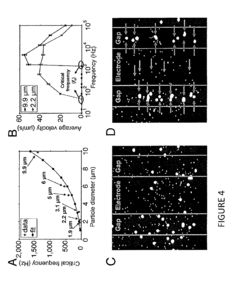Leveraging Ferrofluid for Innovations in Computational Biology
JUL 9, 20259 MIN READ
Generate Your Research Report Instantly with AI Agent
Patsnap Eureka helps you evaluate technical feasibility & market potential.
Ferrofluid in Biocomputing: Background and Objectives
Ferrofluids, a unique class of magnetic nanomaterials, have emerged as a promising frontier in the field of computational biology. These colloidal suspensions of magnetic nanoparticles in a carrier fluid exhibit remarkable responsiveness to external magnetic fields, making them an intriguing subject for innovative applications in biocomputing.
The journey of ferrofluids began in the 1960s when NASA scientist Steve Papell developed them to control liquids in space. Since then, their potential has expanded far beyond aerospace applications, finding relevance in various fields, including biomedicine and, more recently, computational biology. The convergence of ferrofluid technology with biocomputing represents a novel approach to addressing complex biological computations and simulations.
In the realm of computational biology, researchers are increasingly exploring the unique properties of ferrofluids to enhance data processing capabilities and develop new computational paradigms. The ability of ferrofluids to form intricate patterns and structures under magnetic influence opens up possibilities for creating dynamic, reconfigurable computing systems that can mimic biological processes more accurately than traditional silicon-based systems.
The primary objective of leveraging ferrofluids in computational biology is to develop more efficient and biologically relevant computational models. By harnessing the fluid dynamics and magnetic properties of ferrofluids, researchers aim to create systems that can better simulate complex biological phenomena, from molecular interactions to cellular processes and even organ-level simulations.
One of the key goals is to exploit the parallelism inherent in ferrofluid systems. Unlike traditional computing architectures, which process information sequentially, ferrofluid-based systems have the potential to perform multiple computations simultaneously, mirroring the parallel nature of biological systems. This could lead to significant advancements in areas such as protein folding simulations, drug discovery, and genetic analysis.
Another important objective is to develop bio-inspired computing architectures that are more energy-efficient and adaptable than current technologies. Ferrofluids, with their ability to self-organize and respond to external stimuli, offer a promising platform for creating such systems. These could potentially lead to the development of more sustainable and scalable computational solutions for tackling complex biological problems.
As we look towards the future, the integration of ferrofluids into computational biology holds the promise of bridging the gap between in silico and in vivo experiments. By creating more accurate and dynamic models of biological systems, researchers hope to accelerate scientific discoveries and pave the way for groundbreaking advancements in fields such as personalized medicine, environmental modeling, and synthetic biology.
The journey of ferrofluids began in the 1960s when NASA scientist Steve Papell developed them to control liquids in space. Since then, their potential has expanded far beyond aerospace applications, finding relevance in various fields, including biomedicine and, more recently, computational biology. The convergence of ferrofluid technology with biocomputing represents a novel approach to addressing complex biological computations and simulations.
In the realm of computational biology, researchers are increasingly exploring the unique properties of ferrofluids to enhance data processing capabilities and develop new computational paradigms. The ability of ferrofluids to form intricate patterns and structures under magnetic influence opens up possibilities for creating dynamic, reconfigurable computing systems that can mimic biological processes more accurately than traditional silicon-based systems.
The primary objective of leveraging ferrofluids in computational biology is to develop more efficient and biologically relevant computational models. By harnessing the fluid dynamics and magnetic properties of ferrofluids, researchers aim to create systems that can better simulate complex biological phenomena, from molecular interactions to cellular processes and even organ-level simulations.
One of the key goals is to exploit the parallelism inherent in ferrofluid systems. Unlike traditional computing architectures, which process information sequentially, ferrofluid-based systems have the potential to perform multiple computations simultaneously, mirroring the parallel nature of biological systems. This could lead to significant advancements in areas such as protein folding simulations, drug discovery, and genetic analysis.
Another important objective is to develop bio-inspired computing architectures that are more energy-efficient and adaptable than current technologies. Ferrofluids, with their ability to self-organize and respond to external stimuli, offer a promising platform for creating such systems. These could potentially lead to the development of more sustainable and scalable computational solutions for tackling complex biological problems.
As we look towards the future, the integration of ferrofluids into computational biology holds the promise of bridging the gap between in silico and in vivo experiments. By creating more accurate and dynamic models of biological systems, researchers hope to accelerate scientific discoveries and pave the way for groundbreaking advancements in fields such as personalized medicine, environmental modeling, and synthetic biology.
Market Analysis for Ferrofluid-Based Biocomputing Solutions
The market for ferrofluid-based biocomputing solutions is poised for significant growth, driven by the increasing demand for advanced computational tools in biological research and healthcare. Ferrofluids, with their unique magnetic properties and potential for nanoscale manipulation, offer promising applications in areas such as drug delivery, biosensors, and lab-on-a-chip devices.
The global biocomputing market, which encompasses ferrofluid-based solutions, is expected to expand rapidly in the coming years. This growth is fueled by factors such as the rising prevalence of chronic diseases, the need for personalized medicine, and advancements in genomics and proteomics research. The integration of ferrofluids into biocomputing platforms has the potential to enhance the efficiency and accuracy of various biological processes and analyses.
One of the key drivers for ferrofluid-based biocomputing solutions is the increasing focus on precision medicine. As healthcare moves towards more personalized treatment approaches, there is a growing need for advanced computational tools that can process and analyze large volumes of biological data. Ferrofluid-based systems offer the potential for high-throughput screening, rapid diagnostics, and targeted drug delivery, all of which are crucial components of precision medicine initiatives.
The pharmaceutical and biotechnology industries represent significant market segments for ferrofluid-based biocomputing solutions. These industries are constantly seeking innovative technologies to accelerate drug discovery and development processes. Ferrofluid-based platforms can potentially streamline various stages of the drug development pipeline, from initial screening to preclinical testing, thereby reducing time and costs associated with bringing new therapies to market.
Academic and research institutions also constitute a substantial portion of the market for ferrofluid-based biocomputing solutions. As these institutions continue to push the boundaries of biological research, there is an increasing demand for advanced computational tools that can handle complex biological data and simulations. Ferrofluid-based systems offer unique capabilities in areas such as single-cell analysis, protein folding simulations, and molecular dynamics studies.
The healthcare sector presents another significant market opportunity for ferrofluid-based biocomputing solutions. With the growing emphasis on early disease detection and personalized treatment plans, there is a rising demand for advanced diagnostic tools and point-of-care devices. Ferrofluid-based biosensors and lab-on-a-chip devices have the potential to revolutionize disease diagnosis and monitoring, offering rapid, sensitive, and cost-effective solutions for a wide range of medical conditions.
Geographically, North America and Europe are expected to be the leading markets for ferrofluid-based biocomputing solutions, owing to their well-established research infrastructure and high investment in healthcare and life sciences. However, emerging economies in Asia-Pacific and Latin America are likely to witness rapid growth in this market, driven by increasing healthcare expenditure and growing focus on biotechnology research and development.
The global biocomputing market, which encompasses ferrofluid-based solutions, is expected to expand rapidly in the coming years. This growth is fueled by factors such as the rising prevalence of chronic diseases, the need for personalized medicine, and advancements in genomics and proteomics research. The integration of ferrofluids into biocomputing platforms has the potential to enhance the efficiency and accuracy of various biological processes and analyses.
One of the key drivers for ferrofluid-based biocomputing solutions is the increasing focus on precision medicine. As healthcare moves towards more personalized treatment approaches, there is a growing need for advanced computational tools that can process and analyze large volumes of biological data. Ferrofluid-based systems offer the potential for high-throughput screening, rapid diagnostics, and targeted drug delivery, all of which are crucial components of precision medicine initiatives.
The pharmaceutical and biotechnology industries represent significant market segments for ferrofluid-based biocomputing solutions. These industries are constantly seeking innovative technologies to accelerate drug discovery and development processes. Ferrofluid-based platforms can potentially streamline various stages of the drug development pipeline, from initial screening to preclinical testing, thereby reducing time and costs associated with bringing new therapies to market.
Academic and research institutions also constitute a substantial portion of the market for ferrofluid-based biocomputing solutions. As these institutions continue to push the boundaries of biological research, there is an increasing demand for advanced computational tools that can handle complex biological data and simulations. Ferrofluid-based systems offer unique capabilities in areas such as single-cell analysis, protein folding simulations, and molecular dynamics studies.
The healthcare sector presents another significant market opportunity for ferrofluid-based biocomputing solutions. With the growing emphasis on early disease detection and personalized treatment plans, there is a rising demand for advanced diagnostic tools and point-of-care devices. Ferrofluid-based biosensors and lab-on-a-chip devices have the potential to revolutionize disease diagnosis and monitoring, offering rapid, sensitive, and cost-effective solutions for a wide range of medical conditions.
Geographically, North America and Europe are expected to be the leading markets for ferrofluid-based biocomputing solutions, owing to their well-established research infrastructure and high investment in healthcare and life sciences. However, emerging economies in Asia-Pacific and Latin America are likely to witness rapid growth in this market, driven by increasing healthcare expenditure and growing focus on biotechnology research and development.
Current Challenges in Ferrofluid Biocomputing Applications
The integration of ferrofluids into computational biology presents several significant challenges that researchers and developers must address. One primary obstacle is the precise control and manipulation of ferrofluid particles at the microscale. While ferrofluids respond to magnetic fields, achieving the level of precision required for biological computations remains difficult. This challenge is compounded by the need to maintain the stability of ferrofluid suspensions in biological environments, which often contain complex mixtures of proteins, salts, and other biomolecules that can interfere with the magnetic properties of the fluid.
Another critical challenge lies in the development of biocompatible ferrofluids that do not adversely affect living cells or biomolecules. The potential toxicity of nanoparticles used in ferrofluids, as well as their long-term effects on biological systems, must be thoroughly investigated and mitigated. This necessitates extensive research into the synthesis of non-toxic magnetic nanoparticles and surfactants that can maintain the colloidal stability of ferrofluids in physiological conditions.
The integration of ferrofluid-based components with existing biocomputing platforms poses additional challenges. Current biocomputing systems often rely on optical or electrical detection methods, which may not be directly compatible with ferrofluid-based computations. Developing new sensing and readout technologies that can effectively interface with ferrofluid systems is crucial for realizing the full potential of this technology in computational biology.
Scaling up ferrofluid-based biocomputing systems from proof-of-concept experiments to practical applications presents another set of challenges. Issues such as reproducibility, standardization of ferrofluid properties, and the development of robust manufacturing processes for ferrofluid-based biocomputing components need to be addressed. Additionally, the energy efficiency and heat dissipation of ferrofluid-based systems in biological environments must be optimized to ensure their viability for long-term operation.
Lastly, the interdisciplinary nature of ferrofluid biocomputing applications requires collaboration between experts in physics, biology, chemistry, and computer science. Bridging the knowledge gaps between these fields and fostering effective communication and collaboration among researchers from diverse backgrounds remains a significant challenge in advancing this technology.
Another critical challenge lies in the development of biocompatible ferrofluids that do not adversely affect living cells or biomolecules. The potential toxicity of nanoparticles used in ferrofluids, as well as their long-term effects on biological systems, must be thoroughly investigated and mitigated. This necessitates extensive research into the synthesis of non-toxic magnetic nanoparticles and surfactants that can maintain the colloidal stability of ferrofluids in physiological conditions.
The integration of ferrofluid-based components with existing biocomputing platforms poses additional challenges. Current biocomputing systems often rely on optical or electrical detection methods, which may not be directly compatible with ferrofluid-based computations. Developing new sensing and readout technologies that can effectively interface with ferrofluid systems is crucial for realizing the full potential of this technology in computational biology.
Scaling up ferrofluid-based biocomputing systems from proof-of-concept experiments to practical applications presents another set of challenges. Issues such as reproducibility, standardization of ferrofluid properties, and the development of robust manufacturing processes for ferrofluid-based biocomputing components need to be addressed. Additionally, the energy efficiency and heat dissipation of ferrofluid-based systems in biological environments must be optimized to ensure their viability for long-term operation.
Lastly, the interdisciplinary nature of ferrofluid biocomputing applications requires collaboration between experts in physics, biology, chemistry, and computer science. Bridging the knowledge gaps between these fields and fostering effective communication and collaboration among researchers from diverse backgrounds remains a significant challenge in advancing this technology.
Existing Ferrofluid-Based Biocomputing Approaches
01 Composition and preparation of ferrofluids
Ferrofluids are colloidal suspensions of magnetic nanoparticles in a carrier fluid. They typically consist of magnetite or other ferromagnetic materials coated with surfactants to prevent agglomeration. The preparation process involves careful control of particle size and distribution to maintain stability and magnetic properties.- Composition and preparation of ferrofluids: Ferrofluids are colloidal suspensions of magnetic nanoparticles in a carrier fluid. They are typically composed of magnetite or other ferromagnetic materials coated with surfactants to prevent agglomeration. The preparation process involves careful control of particle size and distribution to maintain stability and magnetic properties.
- Applications in sealing and lubrication: Ferrofluids are widely used in sealing and lubrication applications, particularly in rotating shaft seals and bearings. Their unique properties allow them to form liquid seals that can be controlled by magnetic fields, providing effective sealing in various industrial and mechanical systems.
- Magnetic field sensing and measurement: Ferrofluids are utilized in various sensing and measurement applications involving magnetic fields. Their response to magnetic fields allows for the development of sensitive instruments for detecting and measuring magnetic field strength and direction, with applications in scientific research and industrial processes.
- Heat transfer and cooling systems: The unique thermal and magnetic properties of ferrofluids make them suitable for use in heat transfer and cooling systems. They can be manipulated by magnetic fields to enhance heat transfer in electronic devices and other applications where efficient thermal management is crucial.
- Damping and vibration control: Ferrofluids are employed in damping systems and vibration control applications. Their ability to change viscosity in response to magnetic fields allows for adaptive damping in various mechanical systems, improving performance and reducing unwanted vibrations in machinery and structures.
02 Applications in sealing and lubrication
Ferrofluids are used in various sealing and lubrication applications, particularly in rotating shaft seals and bearings. They provide low-friction, liquid-tight seals that can withstand pressure differentials and prevent contamination. These applications are found in hard disk drives, industrial machinery, and aerospace equipment.Expand Specific Solutions03 Magnetic field-responsive devices
Ferrofluids are utilized in devices that respond to magnetic fields, such as sensors, actuators, and dampers. These devices exploit the fluid's ability to change shape, viscosity, or position in response to external magnetic fields, enabling precise control and measurement in various applications.Expand Specific Solutions04 Heat transfer and cooling applications
Ferrofluids are employed in heat transfer and cooling systems, particularly in electronics and power devices. Their unique properties allow for enhanced heat dissipation and targeted cooling when subjected to magnetic fields, improving thermal management in compact or high-power density applications.Expand Specific Solutions05 Measurement and analysis techniques
Various measurement and analysis techniques have been developed for characterizing ferrofluids and their properties. These include methods for determining particle size distribution, magnetic susceptibility, and rheological behavior. Such techniques are crucial for quality control and optimizing ferrofluid performance in different applications.Expand Specific Solutions
Key Players in Ferrofluid and Biocomputing Industries
The field of leveraging ferrofluid for innovations in computational biology is in its early developmental stages, with a growing market potential as researchers explore novel applications. The technology's maturity is still evolving, with academic institutions leading the charge. Key players include the University of California, Yale University, and Arizona State University, who are pioneering research in this interdisciplinary area. Industry involvement is limited but emerging, with companies like Illumina and Emulate showing interest in potential applications. As the technology advances, we can expect increased collaboration between academia and industry, driving market growth and technological refinement in areas such as microfluidics, biosensors, and drug delivery systems.
The Regents of the University of California
Technical Solution: The University of California has developed innovative approaches leveraging ferrofluids for computational biology applications. Their research focuses on using ferrofluid-based microfluidic devices for cell sorting and analysis. The team has created a platform that utilizes magnetic nanoparticles in ferrofluids to manipulate and separate biological cells with high precision[1]. This technology enables rapid and efficient sorting of rare cell populations, which is crucial for various biomedical applications, including cancer diagnostics and stem cell research[2]. The university has also explored the use of ferrofluids in creating dynamic cell culture environments, allowing for the study of cellular responses to mechanical stimuli in a controlled manner[3].
Strengths: High precision cell manipulation, efficient rare cell isolation, and dynamic cell culture capabilities. Weaknesses: Potential complexity in scaling up for high-throughput applications and the need for specialized equipment.
Centre National de la Recherche Scientifique
Technical Solution: CNRS has pioneered the use of ferrofluids in computational biology through the development of magneto-responsive biomaterials. Their research team has created ferrofluid-infused hydrogels that can be manipulated using external magnetic fields, allowing for precise control over the mechanical properties of cell culture substrates[4]. This technology enables the study of mechanobiology and cell-matrix interactions in a dynamic, tunable environment. Additionally, CNRS researchers have explored the use of ferrofluids in creating magnetically actuated microrobots for targeted drug delivery and minimally invasive medical procedures[5]. These microrobots can navigate through complex biological environments, offering potential applications in personalized medicine and tissue engineering.
Strengths: Advanced biomaterial development, precise control over mechanical properties, and potential for targeted drug delivery. Weaknesses: Challenges in long-term biocompatibility and potential limitations in deep tissue applications.
Breakthrough Ferrofluid Innovations for Biocomputing
Systems and methods for controlling shape and position of a ferrofluid droplet
PatentWO2021041471A1
Innovation
- A system comprising a ferrofluid droplet and an electromagnetic field generation system with a controller that determines and applies necessary magnetic field parameters to control the position and shape of the ferrofluid droplet, using PID controllers for precise manipulation, allowing for shape and position control, and simultaneous position and shape control through the generation and manipulation of controlled magnetic fields.
Label-free cellular manipulation and sorting via biocompatible ferrofluids
PatentActiveUS20120237997A1
Innovation
- A microfluidic platform using biocompatible ferrofluids with a microfluidic channel and electrodes that generate a magnetic field pattern, allowing for the controlled manipulation and separation of microparticles and live cells based on size, shape, and elasticity, with high efficiency and rapid separation capabilities.
Biosafety and Bioethics in Ferrofluid Biocomputing
The integration of ferrofluid technology in computational biology raises significant biosafety and bioethical concerns that must be carefully addressed. As this innovative approach gains traction, it is crucial to establish robust safety protocols and ethical guidelines to ensure responsible research and application.
From a biosafety perspective, the primary concern revolves around the potential toxicity of ferrofluids when used in biological systems. The nanoparticles in ferrofluids may interact with cellular components in unpredictable ways, potentially causing damage to DNA, proteins, or cellular structures. Rigorous testing protocols must be developed to assess the short-term and long-term effects of ferrofluid exposure on living organisms at various levels, from individual cells to complex organisms.
Additionally, the magnetic properties of ferrofluids introduce unique safety considerations. The behavior of these fluids under strong magnetic fields must be thoroughly investigated to prevent unintended consequences in biological systems. This includes studying potential heat generation, mechanical stress on cellular structures, and alterations in biochemical processes due to magnetic field interactions.
From an ethical standpoint, the use of ferrofluids in computational biology raises questions about data privacy and the potential for misuse. As these systems may process sensitive biological information, robust data protection measures must be implemented to safeguard individual privacy and prevent unauthorized access or manipulation of genetic data.
Furthermore, the potential for ferrofluid-based biocomputing to enhance human cognitive abilities or modify biological functions presents complex ethical dilemmas. Clear guidelines must be established to delineate acceptable boundaries for research and application, ensuring that advancements in this field align with societal values and respect for human dignity.
The development of international standards and regulatory frameworks is essential to address these biosafety and bioethical concerns. Collaborative efforts between scientists, ethicists, policymakers, and regulatory bodies are necessary to create comprehensive guidelines that balance scientific progress with safety and ethical considerations.
Transparency and public engagement should be prioritized throughout the research and development process. Open dialogue with stakeholders, including the scientific community and the general public, will help build trust and ensure that the development of ferrofluid-based biocomputing technologies aligns with societal needs and values.
From a biosafety perspective, the primary concern revolves around the potential toxicity of ferrofluids when used in biological systems. The nanoparticles in ferrofluids may interact with cellular components in unpredictable ways, potentially causing damage to DNA, proteins, or cellular structures. Rigorous testing protocols must be developed to assess the short-term and long-term effects of ferrofluid exposure on living organisms at various levels, from individual cells to complex organisms.
Additionally, the magnetic properties of ferrofluids introduce unique safety considerations. The behavior of these fluids under strong magnetic fields must be thoroughly investigated to prevent unintended consequences in biological systems. This includes studying potential heat generation, mechanical stress on cellular structures, and alterations in biochemical processes due to magnetic field interactions.
From an ethical standpoint, the use of ferrofluids in computational biology raises questions about data privacy and the potential for misuse. As these systems may process sensitive biological information, robust data protection measures must be implemented to safeguard individual privacy and prevent unauthorized access or manipulation of genetic data.
Furthermore, the potential for ferrofluid-based biocomputing to enhance human cognitive abilities or modify biological functions presents complex ethical dilemmas. Clear guidelines must be established to delineate acceptable boundaries for research and application, ensuring that advancements in this field align with societal values and respect for human dignity.
The development of international standards and regulatory frameworks is essential to address these biosafety and bioethical concerns. Collaborative efforts between scientists, ethicists, policymakers, and regulatory bodies are necessary to create comprehensive guidelines that balance scientific progress with safety and ethical considerations.
Transparency and public engagement should be prioritized throughout the research and development process. Open dialogue with stakeholders, including the scientific community and the general public, will help build trust and ensure that the development of ferrofluid-based biocomputing technologies aligns with societal needs and values.
Interdisciplinary Collaborations for Ferrofluid Biocomputing
The integration of ferrofluid technology with computational biology represents a promising frontier for interdisciplinary collaboration. This convergence of fields offers unique opportunities to leverage the magnetic properties of ferrofluids in biological computing systems. Collaborations between physicists, biologists, and computer scientists are essential to fully exploit the potential of ferrofluid-based biocomputing.
Physicists bring expertise in the behavior of magnetic nanoparticles and fluid dynamics, crucial for optimizing ferrofluid properties for biological applications. Their insights into magnetic field interactions and nanoparticle manipulation are fundamental to designing ferrofluid-based computational systems that can interface with biological components.
Biologists contribute vital knowledge of cellular processes, biomolecular interactions, and genetic information processing. Their understanding of biological signaling pathways and cellular mechanics is critical for developing ferrofluid systems that can effectively interact with and manipulate biological entities at the molecular level.
Computer scientists provide the algorithmic and computational framework necessary to translate ferrofluid-biological interactions into meaningful computational processes. Their expertise in data processing, machine learning, and computational modeling is essential for interpreting and utilizing the complex behaviors observed in ferrofluid-biological systems.
Engineers play a crucial role in designing and fabricating the microfluidic devices and sensors required for ferrofluid biocomputing applications. Their skills in microfabrication, materials science, and system integration are vital for creating functional prototypes and scalable platforms.
Chemists contribute by developing novel ferrofluid formulations tailored for biological compatibility and specific computational tasks. Their expertise in surface chemistry and nanoparticle functionalization is key to creating ferrofluids that can interact precisely with biological molecules and structures.
Collaborative research initiatives should focus on several key areas: developing biocompatible ferrofluids with tunable magnetic properties, creating microfluidic platforms for controlled ferrofluid-biological interactions, designing algorithms to interpret and process ferrofluid-mediated biological signals, and exploring potential applications in areas such as biosensing, drug delivery, and artificial cellular networks.
Interdisciplinary teams should also address challenges such as biocompatibility, long-term stability of ferrofluid-biological interfaces, and scaling computational capabilities. By fostering close collaboration and knowledge exchange between these diverse fields, researchers can accelerate the development of innovative ferrofluid-based biocomputing technologies with far-reaching implications for medicine, biotechnology, and computational science.
Physicists bring expertise in the behavior of magnetic nanoparticles and fluid dynamics, crucial for optimizing ferrofluid properties for biological applications. Their insights into magnetic field interactions and nanoparticle manipulation are fundamental to designing ferrofluid-based computational systems that can interface with biological components.
Biologists contribute vital knowledge of cellular processes, biomolecular interactions, and genetic information processing. Their understanding of biological signaling pathways and cellular mechanics is critical for developing ferrofluid systems that can effectively interact with and manipulate biological entities at the molecular level.
Computer scientists provide the algorithmic and computational framework necessary to translate ferrofluid-biological interactions into meaningful computational processes. Their expertise in data processing, machine learning, and computational modeling is essential for interpreting and utilizing the complex behaviors observed in ferrofluid-biological systems.
Engineers play a crucial role in designing and fabricating the microfluidic devices and sensors required for ferrofluid biocomputing applications. Their skills in microfabrication, materials science, and system integration are vital for creating functional prototypes and scalable platforms.
Chemists contribute by developing novel ferrofluid formulations tailored for biological compatibility and specific computational tasks. Their expertise in surface chemistry and nanoparticle functionalization is key to creating ferrofluids that can interact precisely with biological molecules and structures.
Collaborative research initiatives should focus on several key areas: developing biocompatible ferrofluids with tunable magnetic properties, creating microfluidic platforms for controlled ferrofluid-biological interactions, designing algorithms to interpret and process ferrofluid-mediated biological signals, and exploring potential applications in areas such as biosensing, drug delivery, and artificial cellular networks.
Interdisciplinary teams should also address challenges such as biocompatibility, long-term stability of ferrofluid-biological interfaces, and scaling computational capabilities. By fostering close collaboration and knowledge exchange between these diverse fields, researchers can accelerate the development of innovative ferrofluid-based biocomputing technologies with far-reaching implications for medicine, biotechnology, and computational science.
Unlock deeper insights with Patsnap Eureka Quick Research — get a full tech report to explore trends and direct your research. Try now!
Generate Your Research Report Instantly with AI Agent
Supercharge your innovation with Patsnap Eureka AI Agent Platform!







